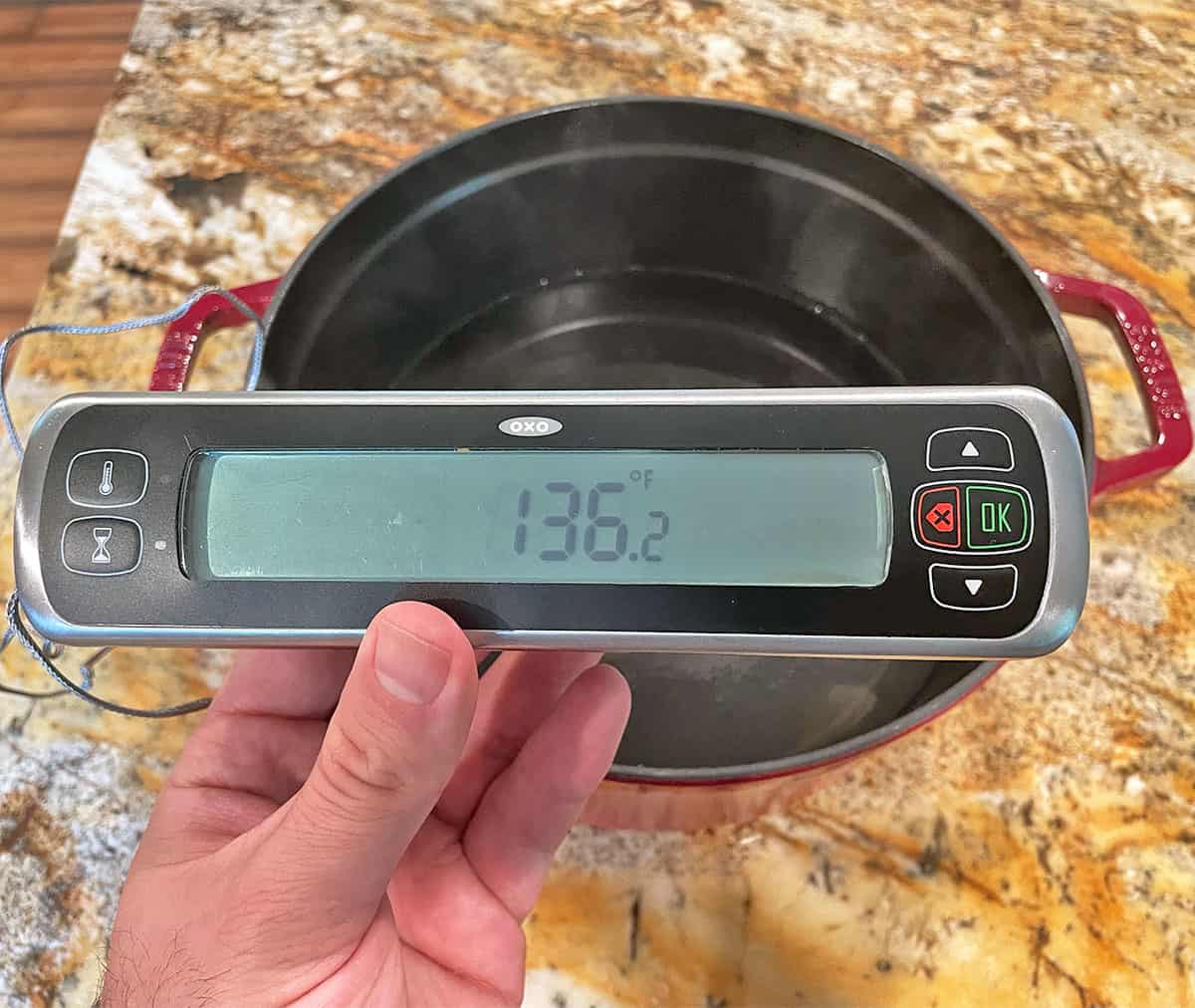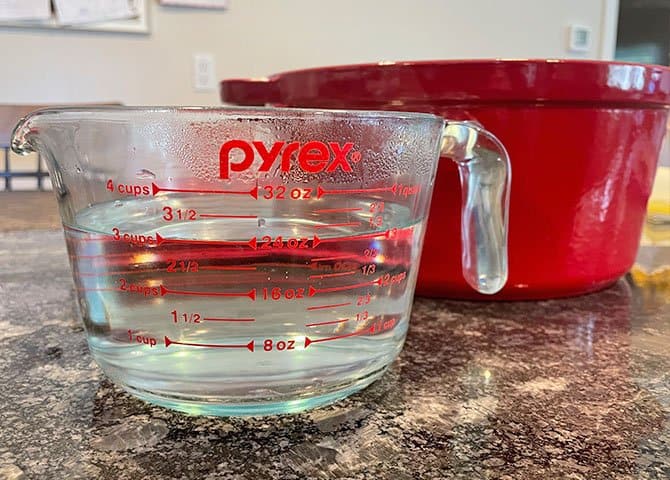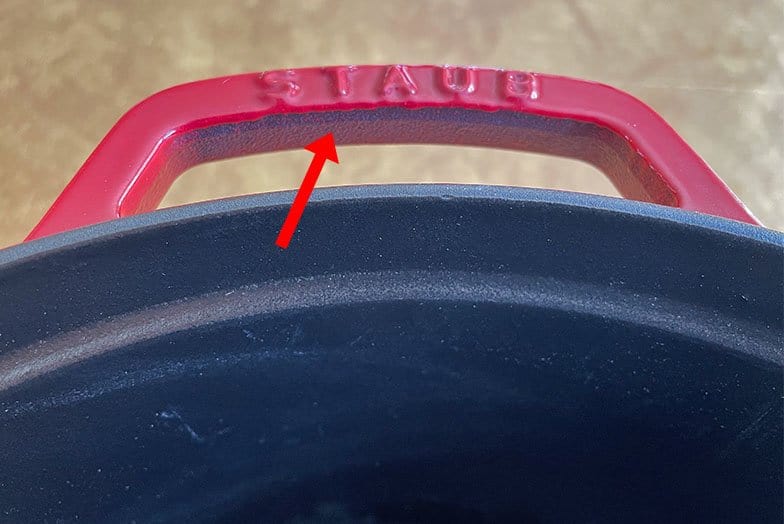Staub has been making enameled cast iron Dutch ovens (also called cocottes) in their French factory since 1974.
But are they worth buying? What makes them special?
In this review, I break down the pros and cons of Staub Dutch ovens. You’ll learn about their construction, design, performance, price, and much more.
I’ll also share my test results that show how it compares to other brands like Le Creuset, Lodge, and Tramontina.
So, keep reading if you’re shopping for a Dutch oven and considering Staub.
Use the links below to navigate the review:
- Staub Dutch Oven Review: Key Takeaways
- Video Review
- Pros of Staub Dutch Ovens
- Cons of Staub Dutch Ovens
- Bottom Line: Are Staub Dutch Ovens Worth Buying?
Staub Dutch Oven Review: Key Takeaways
Below is a quick overview of the pros and cons of Staub Dutch ovens. Throughout the full review, I provide much more detailed analysis and share photos captured during testing.
Pros of Staub Dutch Ovens
- Superior Heat Retention: Based on my testing, Staub retains heat better than top brands like Le Creuset and Lodge, thanks to its thick 4 mm cast iron walls.
- Self-Basting Lid: Staub Dutch oven lids have spikes underneath that redistribute moisture more evenly than a smooth lid. This is not a gimmick; my tests prove it works.
- Moisture Retention: Staub Dutch ovens retain more moisture than leading brands thanks to their tight-fitting lids and unique design (see test results).
- Flat Lid Design: You can rest a spoon or place ice on Staub’s flat lid. The ice cools the lid, which quickly converts steam inside the pot back to liquid. This process prevents steam from escaping.
- Oven-Safe to 500°F: Staub Dutch ovens are oven-safe up to 500°F (including the knobs).
- Custom Knobs: Staub allows you to customize your Dutch oven’s knob to match your style or help distinguish between multiple pots. They offer knobs shaped like various animals.
- Dark Interior: The dark matte enamel on the interior resists stains and scratches better than light interiors.
- Durable Construction: The thick 4mm cast iron walls make Staub Dutch ovens highly durable and long lasting.
- Value: Staub Dutch ovens aren’t cheap, but they’re less expensive than comparable sizes and colors of Le Creuset.
Cons of Staub Dutch Ovens
- Small Handles: The space between Staub handles and the pot is less than an inch. For comparison, Le Creuset handles have a 1.25-inch opening.
- Rough Handles: Paint and enamel don’t cover the inside of the handles, exposing a rough texture.
- Small Lid Knobs: The diameter of the lid knobs is 1.25 inches, which makes them harder to grip with bulky oven mitts. For comparison, the diameter of Made In’s knob is 2.25 inches.
- Dark Interior: The matte black enamel makes it more difficult to monitor browning compared to lighter interiors.
- Heavy: Weighing 12.8 pounds empty (5.5-quart oven), the heft of Staub Dutch ovens makes lifting and maneuvering them more difficult.
- Limited Colors: Staub offers around a dozen colors, less variety than Le Creuset’s 20+ shade options.
Bottom Line
Performance-wise, Staub Dutch ovens are as good as it gets. They retain heat and moisture better than the competition, and their self-basting lids redistribute moisture evenly across the pot. But the smaller handles and lid knobs pose some maneuverability challenges. Is Staub worth buying? Absolutely. It’s made in France and is one of the best alternatives to Le Creuset.
Visit Zwilling.com and Amazon to read more reviews and check the current prices.
Video Review
Watch me break down the pros and cons of Staub Dutch ovens in the quick video below.
Pros of Staub Dutch Ovens
There’s a lot to love about Staub Dutch ovens. The most noteworthy advantages are their superior heat and moisture retention, but there’s so much more. Let’s explore the benefits of Staub.
Heat Retention
Staub Dutch ovens, with their thick 4 mm walls and substantial weight — 12.8 pounds for a 5.5-quart, to be exact — retain heat exceptionally well.

Why is this important? When a Dutch oven retains heat efficiently, it cooks your food more evenly, particularly when searing meat or adding ingredients that might change the temperature.
How do I know Staub retains heat well? Besides cooking with it for several years, I conducted a simple controlled test.
I boiled 32 ounces of water in the Staub 5.5-quart Dutch oven. Once the water began boiling, I removed the pot from the heat and let it cool on the counter.
As it cooled, I measured the temperatures at 10- and 20-minute intervals.
After ten minutes, the water was 136.2°F.

After 20 minutes, the water was 111.3°F.

I repeated this test with Tramontina, Lodge, Le Creuset, and Great Jones Dutch ovens. Here are the results:
| Dutch Oven | Water Temperature (10 minutes) | Water Temperature (20 minutes) |
|---|---|---|
| Staub | 136.2°F | 111.3°F |
| Tramontina | 134.1°F | 108.8°F |
| Lodge | 130.8°F | 105.6°F |
| Le Creuset | 129.4°F | 103.5°F |
| Great Jones | 128.6°F | 102.3°F |
Based on these results, Staub Dutch ovens retain heat better than the competition, with Tramontina coming in close second and Lodge not far behind in third. Interestingly, the renowned brand Le Creuset landed in fourth place.
Self-Basting Lid
If you look closely at the inside of Staub’s lid, you’ll notice tiny bumps. These aren’t just for show. They’re designed to capture evaporating liquid and evenly redistribute it back into the pot.

But does this design really work? Or is it just a clever marketing gimmick?

I wanted answers, so I conducted another test using a Staub Dutch oven and a Le Creuset Dutch oven. Le Creuset’s lid is smooth on the bottom without any bumps.

This test aimed to see if Staub’s self-basting lid distributes moisture more evenly across the pot.
Here’s what I did:
I filled a Staub and Le Creuset Dutch oven with 32 ounces of water and brought them to a boil.
After letting them bubble away for 10 minutes to build up a good amount of steam, I quickly lifted the lids without tilting them and placed them on a paper towel on a sheet pan. I let the lids rest on the paper towels for 20 seconds.

What I found was intriguing. The paper towel under the Staub lid was dotted with water droplets, and those droplets were evenly spread out. In contrast, the paper towel under the Le Creuset lid had fewer droplets, and they weren’t as evenly distributed.

I repeated the test a second time and got similar results.

These simple tests prove that the small dimples on the Staub lid effectively redistribute moisture, ensuring your food remains juicy and doesn’t dry out.
So, does this feature translate to better-tasting food in a Staub? It depends on what you’re cooking. For dishes that are enhanced by continuous self-basting, the answer is yes.

However, for recipes like soups, chilis, or sauces, the even distribution of condensation won’t give you a significantly different outcome.
Moisture Retention
With their snug lids, Dutch ovens have a reputation for locking in moisture, ensuring that whatever you’re cooking stays juicy and tender.
But sometimes, like when reducing a sauce, you’d want some moisture to escape. If you ever find yourself in that situation with Staub, you can simply tilt the lid or remove it altogether.
When the lid’s in place, though, how effective is it at keeping that precious moisture in?
To dig into this, I conducted another test.
I poured 32 ounces of water into a Staub Dutch oven, brought it to a boil, and let it simmer for 15 minutes.

After 15 minutes, I turned the heat off and let the pot rest for an additional 30 minutes with the lid on.
When I finally lifted the lid and measured the remaining water, Staub retained almost all 32 ounces.

But how does Staub measure up to other brands? I ran the same test with Lodge, Tramontina, Le Creuset, and Great Jones. Here are the results:
| Dutch Oven | Water Retained |
|---|---|
| Staub | 32 ounces |
| Lodge | 30 ounces |
| Tramontina | 29 ounces |
| Le Creuset | 28 ounces |
| Great Jones | 26 ounces |
Based on this test, Staub retains moisture better than the competition.
Flat Lid
One of the distinctive features of Staub Dutch ovens is their flat lid design. But beyond its sleek appearance, the flat lid serves practical purposes, too.
Since the lid isn’t sloped like most Dutch ovens, you can place ice on top without it sliding off.

The ice helps retain moisture by converting rising steam back into liquid.
Here’s how it works.
When the hot steam from inside the pot makes contact with the cooled surface of the lid, it quickly condenses back into liquid, dripping back into your dish. This technique ensures an even more moist environment for your cooking.
Another handy use for the flat lid? Resting a spoon, spatula, or tongs without the fear of it sliding off.

Oven-Safe Lid Knobs
If you’ve ever hesitated before placing your Dutch oven in the oven, worried about whether the lid’s knob can withstand the heat, Staub has you covered.
Their Dutch ovens come with lid knobs constructed from steel, coated in nickel or brass. These knobs can comfortably endure temperatures up to 500°F.
Customizable Lid Knobs
Another feature that sets Staub apart is their option for customizable lid knobs.
If the standard knobs doesn’t speak to your style, Staub allows you to swap it out for something more unique. They offer knobs shaped like a cow, rooster, fish, or pig.
If you plan to use multiple Dutch ovens simultaneously, these distinct knobs can be a clever way to quickly identify what each pot contains.
So, you’re not just adding a personal touch but also making your cooking process smoother.
Interior Finish
Staub Dutch ovens come with a matte black finish inside. One immediate benefit of this dark hue is its resilience against visible stains.

Unlike lighter finishes, this matte black interior doesn’t show discoloration or scratches as easily. So, your Staub Dutch oven will look newer for longer.
Durability
Staub Dutch ovens have thick cast iron construction, making them inherently durable. But that’s not unique since almost all Dutch ovens are made of cast iron.
Staub stands out because its walls are thicker than most. I used a digital micrometer to measure the top portion of Staub’s walls, which are 4.2 mm thick.

For comparison, Le Creuset Dutch ovens are 3.6 mm thick. That additional thickness in Staub ovens gives you both heft and added durability.

While enamel can chip if you’re too rough, the thick cast iron beneath ensures your oven won’t crack or warp.
Less Expensive Than Le Creuset
Staub is an excellent option if you’re in the market for a premium Dutch oven but also looking for value.
Don’t get me wrong, Staub is not cheap. In fact, it’s one of the more expensive Dutch oven brands.
But most people considering Staub are also considering Le Creuset. And between the two, Staub is the better value. Depending on the size and color you choose, you could be saving anywhere from $20 to $50.
Check the current prices on Zwilling.com (Zwilling owns Staub) and Amazon.
Cons of Staub Dutch Ovens
While Staub Dutch ovens have some impressive pros, they also have drawbacks. Let’s delve into some of the areas where Staub falls short.
Small Handles
Staub Dutch oven handles are small. The opening between the handle and the pot is less than an inch.

While this may seem like a minute detail, it can make quite the difference when trying to get a good grip on a hot and heavy pot, especially with oven mitts on.

For comparison, Le Creuset Dutch oven handles have a generous 1.25-inch opening. That extra space can significantly improve the comfort and stability of your grip.

Rough Handles
Another aspect to consider with Staub Dutch ovens is the texture of their pot handles. The interior side of these handles exposes the bare cast iron, which might feel coarse to the touch.

People in forums claim the rough texture inside Staub Dutch oven’s handles is an intentional design choice to prevent slippage.
But in reality, it’s just a limitation in their manufacturing process. As you can see in this video, machines spray paint onto the spinning Dutch oven. Due to the handle’s shape and the positioning of the spray, the paint doesn’t fully coat its inner portion.
This doesn’t impact the performance or function, but it looks unfinished.
Small Lid Knobs
At just 1.25 inches in diameter, Staub’s knobs are smaller than competitors like Le Creuset and Made In. Those two brands’ knobs are 2.25 inches wide.



Staub’s petite knobs can be hard to grasp firmly, particularly when wearing bulky oven mitts. The thin stem attaching the knob to the lid exacerbates this issue. Your fingers have minimal clearance to get underneath the knob.

Larger, wider knobs like Made In and Le Creuset provide more leverage and control when lifting and tilting the lid.
Dark Interior
Earlier in this review, I mentioned Staub’s dark interior as a pro since it hides stains and scratches, but it’s also a con.
Compared to lighter interiors like Le Creuset’s sand-colored one, the darker hue makes it trickier to spot fond development or ensure that your food isn’t sticking or burning.


Weight
With thick 4 mm walls, the Staub 5.5-quart Dutch oven tips the scales at a substantial 12.8 pounds empty.

That’s noticeably heavier than many competing Dutch ovens. For example, the Le Creuset 5.5-quart Dutch oven weighs 11.5 pounds.

When you fill the pot with food and liquid, maneuvering it takes serious arm strength. If you lack grip strength or have wrist issues, this heavy pot may be difficult to handle safely.
Limited Color Options
Staub’s Dutch ovens are available in around a dozen color options.
While this might seem like a lot of choices, it pales in comparison to brands like Le Creuset, which boasts around 20 shades and is known for regularly introducing new hues.
If you’re looking for a specific color to match your kitchen decor or personal style, Staub’s selection is a bit restrictive.
Bottom Line: Are Staub Dutch Ovens Worth Buying?
So, should you buy a Staub Dutch oven? Is it worth the investment?
In my opinion, yes.
As my testing proved, the thick walls and tight-fitting lid retain heat better than the competition, and the self-basting lid distributes moisture back over the pot much more evenly than a domed lid with no bumps.
One of my favorite features of Staub Dutch ovens is their flat lids that allow you to rest a spoon or place ice to retain even more moisture.
Although they’re heavy and the lid knobs and side handles are smaller than other brands, you can still get a secure grip. Plus, Dutch ovens are primarily used for slow cooking — it’s not the type of pot you need to move frequently.
Bottom line — Staub is one of the world’s best enameled cast iron cookware brands. And, based on my testing, their French-made Dutch ovens perform as well or better than other well-established (and more expensive) brands like Le Creuset. If you’re looking for an elegantly designed, high-performing Dutch oven for soups, stews, braises, and other slow-cooked meals, Staub is one of the best options.
Check the current prices and read more reviews on Zwilling.com (Zwilling owns Staub) or Amazon.
Related Topics
- Staub vs. Lodge: Which Dutch Ovens Are Better?
- Staub vs. Le Creuset: Which Dutch Ovens Are Better?
- 9 French Cookware Brands: The Best Pots & Pans Made in France
- 5 Cheaper Alternatives to Le Creuset Dutch Ovens
- Best Cookware NOT Made in China: The Definitive Guide
- 18 Pros and Cons of Enameled Cast Iron Cookware (Complete List)
- Made In vs. Le Creuset: Which Dutch Ovens Are Better?
- Lodge Dutch Oven In-Depth Review: Pros and Cons You Need to Know
- Lodge vs. Tramontina: Which Dutch Ovens Are Better?
- Le Creuset vs. Tramontina: Which Dutch Ovens Are Better?
- Is Le Creuset Worth the High Price? An In-Depth Review
- Great Jones vs. Le Creuset: Which Dutch Oven Is Better?
- Caraway vs. Le Creuset: Which Cookware Is Better?
- Oval vs. Round Dutch Ovens: Which Shape Is Better?

